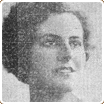 | |||||||||
| |||||||||
In 1921, Mollie Lee received generous press attention for her dance drama, The Lost Child, which was presented by her pupils at the Avenue Theatre. One of the dancers, Baby Jane Tait, was only four years old, according to a photo caption on the Sun's society page on May 26, one of a number of photos featuring beautifully costumed youngsters that preceded the event. When the lengthy, unsigned review appeared, it singled out Tait for praise: “When wee Jane Tait, as 'apple blossoms', came forward in her cute baby way and bowed her acknowledgements, she was given tumultuous applause.” Apparently the whole show was a huge success. From the Sun, May 30, 1921: From the moment the Avenue Theatre curtain lifted on Saturday on the dance drama, “The Lost Child,” and disclosed a row of adorable little tots in front of the large class, to the final scene - marked by many flowers passing over the footlights - the enjoyment of the large audience was shown by enthusiastic and frequent applause. The production was beautifully costumed, and with its varied and graceful dances would have done credit to a much larger city than Vancouver. The detailed review tells us exactly what was performed. “Graceful Exercises by Class” and a song began the program, after which “eight little girls in quaint sunbonnets gave a frolic.” This was followed by a flower ballet, with solo dancers performing as Buttercups, Marguerites, Apple Blossoms, Chrysanthemums and The Rose. After a song from wee Tait, a skillful Toe Ballet was danced by “five pretty maids”, followed by a Butterfly Ballet. A Skipping Rope Dance closed the first act. The second act featured a gypsy duet, a tambourine revel, a trio, an Egyptian ballet “by five clever dancers,” two solos, two “dear little children” in a minuet, a shepherdess dance, a Polish dance, an eccentric dance and, finally, a Dance of Joy to close “a very fine performance.” How this was all tied together into a dance drama had been revealed by a society page contributor some days earlier, when the plot was told at length. In short, some gypsies steal young Nora and her distraught nurse plots to get her back. The end of the preview suggests civic pride in local talent was in a healthy state: All the foregoing will be interpreted by dramatic expression and gesture, with the motion and rhythm of the dance, the romance and story conceived by one of our own citizens, for impersonation by our own local talent, wonderful child artistes, pupils of a past master of the art and beauty of the dance (Sun, May 22, 1921). In 1923, the fact that the American President just missed seeing Lee dance was considered worthy of note. “This dainty danseuse”, said the Province on August 1, “who has brought delight to thousands with her beautiful art, and who was selected to dance before the Prince of Wales, had also been retained to dance before President Harding. But alas ... before the speeches were barely over the President was whisked away to his transport....” Lee, who had presented her own ballets in England and France during World War I, was also known as Mrs. Andy Blygh. When her daughter, Betty Blygh, was a youngster she carried on her mother's tradition of dancing for worthy causes. Betty Blygh, the cousin of renowned Canadian choreographer Brian Macdonald, taught at Kay Armstrong's school in the 1950s and connects us once more to Armstrong and a later decade in Vancouver. (next page)
©2006, Dance Collection Danse | ||||
| ||||



